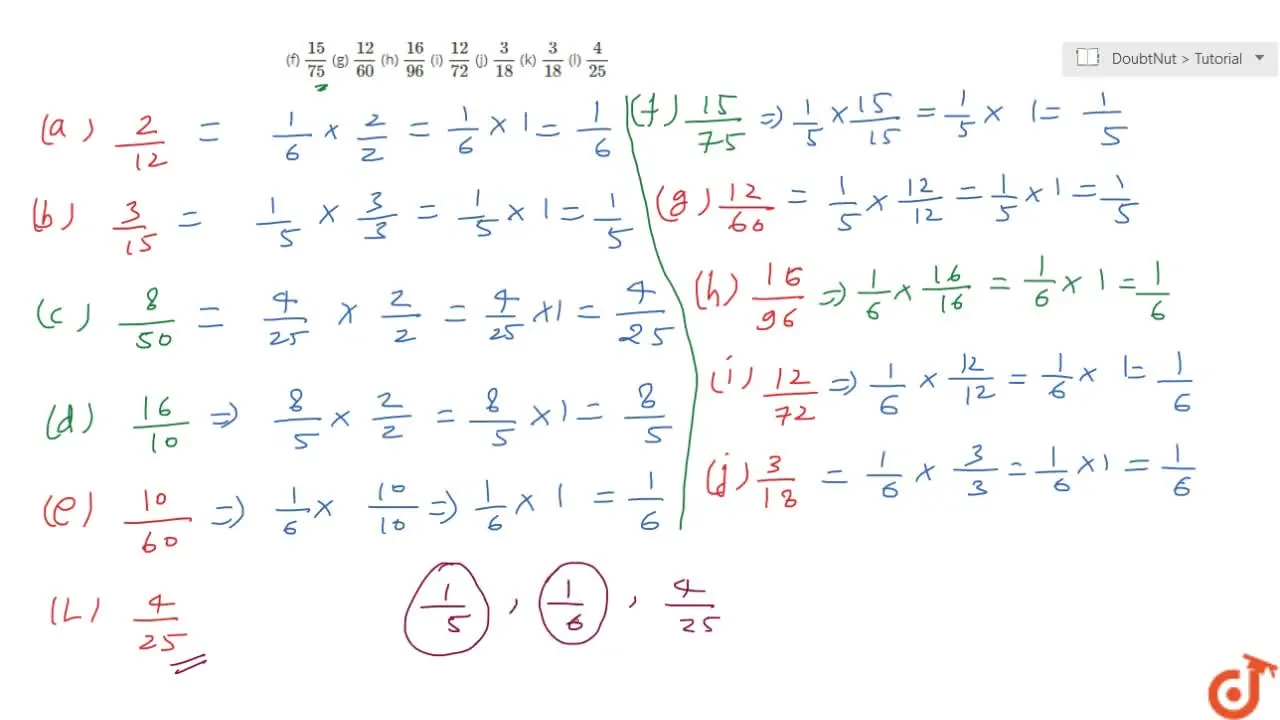The following fractions represent just three different numbers. Separate them into three groups of equivalent fractions, by changing each one to its simplest form.
(a) 212
(b) 315
(c) 850
(d) 1610
(e) 1060
(f) 1575
(g) 1260
(h) 1696
(i) 1272
(j) 318
(k) 318
(l) 425
(a) '2 / 12 = (1 × 2) / (6 × 2)
= 1 / 6'
(b) '3 / 15 = (1 × 3) / (5 × 3)
= 1 / 5'
(c) '8 / 50 = (4 × 2) / (25 × 2)
= 4 / 25'
(d) '16 / 100 = (4 × 4) / (25 × 4)
= 4 / 25'
(e) '10 / 60 = (1 × 10) / (6 × 10)
= 1 / 6'
(f)' 15 / 75 = (1 × 15) / (5 × 15)
= 1 / 5'
(g) '12 / 60 = (1 × 12) / (5 × 12)
= 1 / 5'
(h) '16 / 96
= (1 × 16) / (6 × 16)
= 1 / 6'
(i) '12 / 75 = (4 × 3) / (25 × 3)
= 4 / 25'
(j) '12 / 72 = (1 × 12) / 6 × 12)
= 1 / 6'
(k) '3 / 18 = (1 × 3) / (6 × 3)
= 1 / 6'
(l) '4 / 25'
Totally there are 3 groups of equivalent fractions.
'1 / 6 =' (a), (e), (h), (j), (k)
'1 / 5 =' (b), (f), (g)
'4 / 25 =' (d), (i), (l)
Related Playlists
- BOOK - NCERTCHAPTER - FRACTIONSEXERCISE - SOLVED EXAMPLES13videos
FRACTIONS
- BOOK - NCERTCHAPTER - FRACTIONSEXERCISE - EXERCISE 7.69videos
FRACTIONS
- BOOK - NCERTCHAPTER - FRACTIONSEXERCISE - EXERCISE 7.55videos
FRACTIONS
- BOOK - NCERTCHAPTER - DECIMALSEXERCISE - EXERCISE 8.110videos
DECIMALS
- BOOK - NCERTCHAPTER - INTEGERSEXERCISE - EXERCISE 6.34videos
INTEGERS
Similar Questions
The following fractions represent just three different numbers. Separate them in to three groups of equal fractions by changing each one to its simplest form: 1275 (ii) 1272 (iii) 318 (iv) 425
View SolutionSolve :
(a) 118+118
(b) 815+315
(c) 75−57
(d) 122+2122
(e) 1215−715
(f) 58+38
(g) (1)−23
(h) 14+04
(i) 3−125View SolutionWrite the following decimals as fractions. Reduce the fractions to lowest form.(a) 0.6 (b) 2.5 (c) 1.0 (d) 3.8 (e) 13.7 (f) 21.2 (g) 6.4
View SolutionWhich of the following is a fraction equivalent to 23 ? 45 (b) 86 (c) 1025 (d) 1015
View SolutionExpress the following fractions as decimals: 1212 (ii) 7514 (iii) 2518
View SolutionThree numbers are in the ratio 1 : 2 : 3 and their H.C.F. is 12. The numbers are (a) 4, 8, 12 (b) 5, 10, 15 (c) 10, 20, 30 (d) 12, 24, 36
View SolutionList out the proper and improper fractions from the following .
(a) 7/2 , (b) 3/4 , (c ) 5/2
(d) 11/13 , (e ) 7/15 , (f) 17/13
(g) 72/21, (h) 81/87 , (i) 16/15
(j) 20/29View SolutionConvert each of the following into an improper fraction: 714 (ii) 857 (iii) 5310 (iv) 12715
View SolutionState (a) if the fractions are in ascending order state (b) if the fractions are in descending order
3/5 , 7/9 , 13/8View SolutionIf a−b=3 and a2+b2=29 , find the value of ab . (a) 10 (b) 12 (c) 15 (d) 18
View Solution


